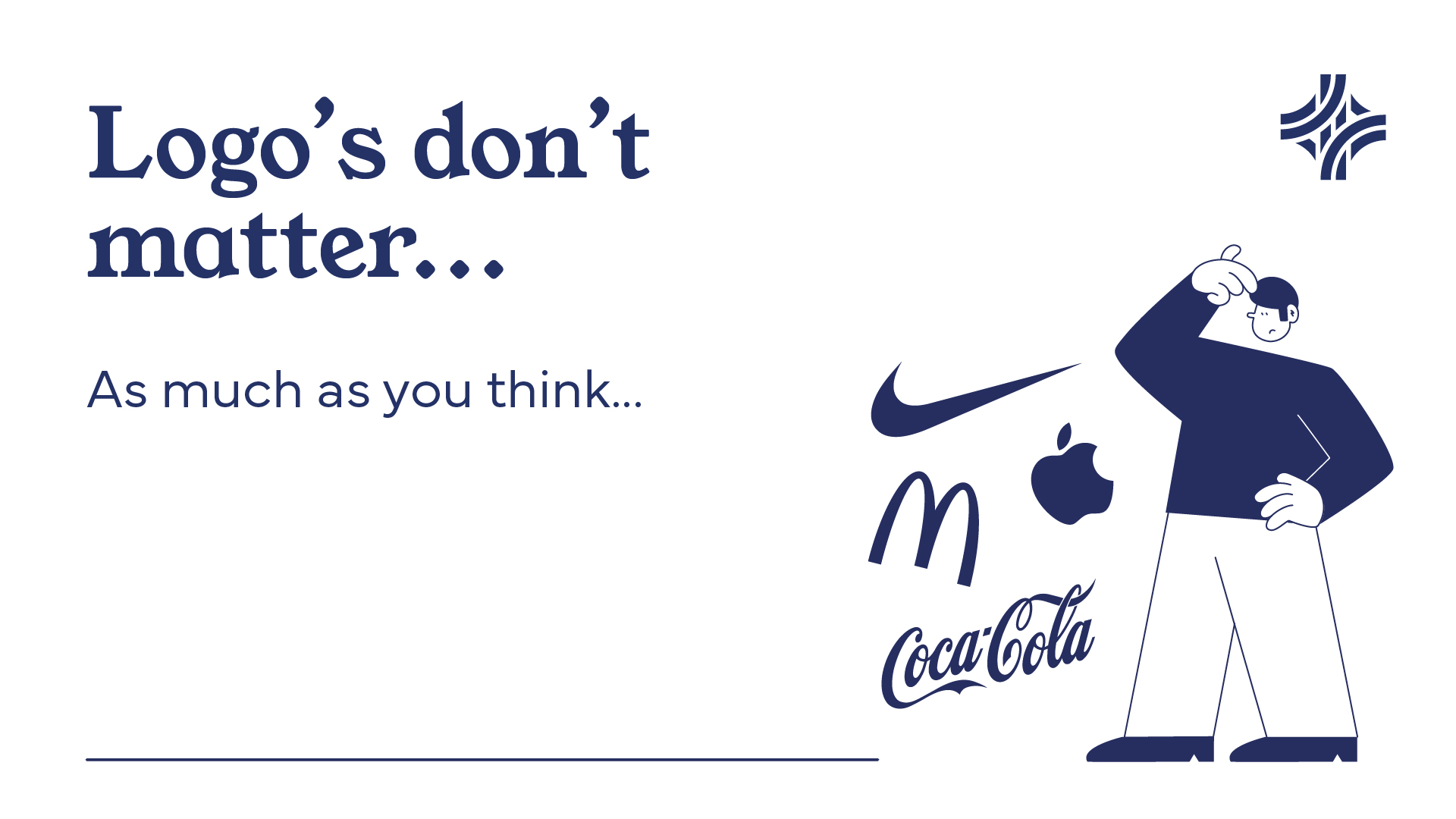
Logos Don’t Matter (As Much As You Think)
For years, businesses, especially start-ups, have poured disproportionate amounts of time, money, and emotional energy into creating the perfect brand logo design. The common wisdom dictates that a powerful, memorable logo is the cornerstone of a successful brand. But what if we told you that, while important, your logo might not be the be all and end all you've been led to believe.
In today's fast paced, highly visual world, a logo is just one piece of a much larger, more intricate puzzle. The truth is, your logo doesn't work in isolation. Its effectiveness is deeply intertwined with a myriad of other elements that collectively form your true brand identity.
The Illusion of the Standalone Logo
Think about it - when you interact with your favourite brands, is it just their logo that resonates with you? Or is it the entire experience? The consistent tone of voice, the quality of their products, the user experience on their website, the feel of their packaging design, the customer service, and yes, the visual appeal of their marketing materials. All of these contribute far more to your perception than a single graphic mark.
A logo is a symbol, a shorthand representation of a brand. It's a flag, not the entire kingdom. The kingdom, your brand, is built on consistent actions, values, and a unified visual and verbal language.
What Truly Builds a Brand Identity?
So, if not just the logo, what truly matters?
- Your Brand's Story and Values: Why do you exist? What problem do you solve? What do you believe in? This foundational narrative is what connects with people on an emotional level. Your logo should reflect this story, not create it.
- Consistent Visual Language Beyond the Logo: This is where brand guidelines become invaluable. They dictate everything from your chosen colour palette, typography, imagery style, and even the way your logo is used (or not used). A consistent visual language creates instant recognition, even without the logo present. Think about the distinctive yellow of a famous fast food chain or the unique typeface of a luxury car manufacturer.
- Customer Experience: How do people feel when they interact with your brand? Is it easy, enjoyable, reliable? A clunky website, poor customer service, or inconsistent product quality can quickly undermine even the most beautiful logo.
- Product/Service Quality: This should go without saying, but a fantastic product or service that consistently delivers on its promise is the ultimate brand builder. No amount of clever brand logo design can compensate for a subpar offering.
- Tone of Voice: How does your brand "speak"? Is it formal, playful, authoritative, friendly? This verbal identity is just as crucial as the visual one, especially in marketing, social media, and customer communications.
The Power of the Ecosystem
Imagine a tree. The logo is merely a leaf. A leaf alone cannot survive or represent the entire tree. The tree needs roots (your values, mission), a strong trunk (your core product/service), branches (your marketing channels), and consistent care (customer experience, quality). When all these elements work in harmony, the leaf (your logo) gains meaning and recognition.
Take Nike, for example. The "swoosh" is iconic. But it's iconic because it's been consistently associated with innovation, athletic achievement, and inspiring stories for decades. If Nike started producing faulty products or had terrible customer service, the swoosh would quickly lose its power. Its strength comes from the entire brand identity ecosystem it represents.
When Does Your Logo Really Matter?
While we argue it's not the most important thing, a good logo certainly plays a role.
- First Impressions: It's often the first visual touchpoint. A professional, well designed logo creates an initial sense of credibility and professionalism.
- Memorability: A distinctive logo can aid recall, making it easier for people to remember your brand amongst competitors.
- Differentiation: A unique logo helps you stand out in a crowded market.
- Versatility: A truly effective logo should work across all mediums, from a tiny app icon to a large billboard, on packaging design, and digital ads. This is where the importance of well defined brand guidelines comes in, ensuring its consistent and effective application.
Don't Obsess, Instead Invest Wisely
Instead of fixating solely on your logo, distribute your resources more intelligently. Invest in understanding your target audience, crafting your brand story, developing strong brand guidelines, ensuring consistent quality in your offerings, and delivering exceptional customer experiences.
Your logo will naturally become powerful as it becomes associated with all these positive interactions and perceptions. It's the symbol that gains meaning from your actions, not the one that creates it.
Ready to Build a Stronger Brand?
If you're looking to develop a comprehensive brand identity that goes beyond just a brand logo design and truly connects with your audience, we can help. From crafting compelling brand stories to developing robust brand guidelines and impactful packaging design, we're here to guide you.
Contact us today for a free brand consultation!
Explore our portfolio to see how we build complete brand experiences.
Q&A:
Q: Should I just get a cheap logo online?
A: No. While your logo isn't everything, a poorly designed, unprofessional logo can still send the wrong signals. Invest enough to ensure it's well crafted, versatile, and reflects your brand's essence. The point is not to under invest, but to ensure you're proportionately investing in all aspects of your brand identity, not just the logo.
Q: What are "brand guidelines" and why are they so important?
A: Brand guidelines are a comprehensive document that defines how your brand looks, feels, and communicates. They cover everything from your logo's usage, colour palettes, typography, imagery style, tone of voice, and even legal considerations. They are crucial because they ensure consistency across all your touchpoints, building a cohesive and recognisable brand identity over time. Without them, your brand can appear disjointed and unprofessional.
Q: How does packaging design tie in to my brand identity?
A: Packaging design is a critical physical touchpoint where your brand identity comes to life. It's often the first tangible interaction a customer has with your product. Effective packaging communicates your brand's values, quality, and personality through its colours, typography, materials, and overall aesthetic. It reinforces the message conveyed by your logo and other marketing efforts, creating a cohesive and memorable brand experience.
Q: My logo is quite old and I'm thinking of a redesign. What should I consider?
A: A redesign can be a great opportunity! Don't just focus on making it "look new." Instead, consider if your current logo still accurately reflects your brand's current values, mission, and target audience. A redesign should aim to improve versatility, modernise without losing recognition (if that's a goal), and align better with your overall brand identity strategy. Work with a designer who understands these broader strategic goals.


